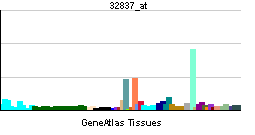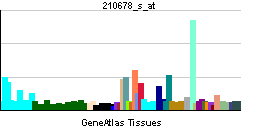AGPAT2
| 1-acylglycerol-3-phosphate O-acyltransferase 2 (lysophosphatidic acid acyltransferase, beta) | |||||||||||
|---|---|---|---|---|---|---|---|---|---|---|---|
| Identifiers | |||||||||||
| Symbols | AGPAT2 ; 1-AGPAT2; BSCL; BSCL1; LPAAB; LPAAT-beta | ||||||||||
| External IDs | Template:OMIM5 Template:MGI HomoloGene: 4678 | ||||||||||
| |||||||||||
| RNA expression pattern | |||||||||||
 | |||||||||||
 | |||||||||||
| More reference expression data | |||||||||||
| Orthologs | |||||||||||
| Template:GNF Ortholog box | |||||||||||
| Species | Human | Mouse | |||||||||
| Entrez | n/a | n/a | |||||||||
| Ensembl | n/a | n/a | |||||||||
| UniProt | n/a | n/a | |||||||||
| RefSeq (mRNA) | n/a | n/a | |||||||||
| RefSeq (protein) | n/a | n/a | |||||||||
| Location (UCSC) | n/a | n/a | |||||||||
| PubMed search | n/a | n/a | |||||||||
1-acylglycerol-3-phosphate O-acyltransferase 2 (lysophosphatidic acid acyltransferase, beta), also known as AGPAT2, is a human gene.[1]
This gene encodes a member of the 1-acylglycerol-3-phosphate O-acyltransferase family. The protein is located within the endoplasmic reticulum membrane and converts lysophosphatidic acid to phosphatidic acid, the second step in de novo phospholipid biosynthesis. Mutations in this gene have been associated with congenital generalized lipodystrophy (CGL), or Berardinelli-Seip syndrome, a disease characterized by a near absence of adipose tissue and severe insulin resistance. Alternate transcriptional splice variants, encoding different isoforms, have been characterized.[1]
References
Further reading
- Garg A (2004). "Acquired and inherited lipodystrophies". N. Engl. J. Med. 350 (12): 1220–34. doi:10.1056/NEJMra025261. PMID 15028826.
- West J, Tompkins CK, Balantac N; et al. (1997). "Cloning and expression of two human lysophosphatidic acid acyltransferase cDNAs that enhance cytokine-induced signaling responses in cells". DNA Cell Biol. 16 (6): 691–701. PMID 9212163.
- Eberhardt C, Gray PW, Tjoelker LW (1997). "Human lysophosphatidic acid acyltransferase. cDNA cloning, expression, and localization to chromosome 9q34.3". J. Biol. Chem. 272 (32): 20299–305. PMID 9242711.
- Stamps AC, Elmore MA, Hill ME; et al. (1997). "A human cDNA sequence with homology to non-mammalian lysophosphatidic acid acyltransferases". Biochem. J. 326 ( Pt 2): 455–61. PMID 9291118.
- Aguado B, Campbell RD (1998). "Characterization of a human lysophosphatidic acid acyltransferase that is encoded by a gene located in the class III region of the human major histocompatibility complex". J. Biol. Chem. 273 (7): 4096–105. PMID 9461603.
- Garg A, Wilson R, Barnes R; et al. (1999). "A gene for congenital generalized lipodystrophy maps to human chromosome 9q34". J. Clin. Endocrinol. Metab. 84 (9): 3390–4. PMID 10487716.
- Agarwal AK, Arioglu E, De Almeida S; et al. (2002). "AGPAT2 is mutated in congenital generalized lipodystrophy linked to chromosome 9q34". Nat. Genet. 31 (1): 21–3. doi:10.1038/ng880. PMID 11967537.
- Strausberg RL, Feingold EA, Grouse LH; et al. (2003). "Generation and initial analysis of more than 15,000 full-length human and mouse cDNA sequences". Proc. Natl. Acad. Sci. U.S.A. 99 (26): 16899–903. doi:10.1073/pnas.242603899. PMID 12477932.
- Simha V, Garg A (2003). "Phenotypic heterogeneity in body fat distribution in patients with congenital generalized lipodystrophy caused by mutations in the AGPAT2 or seipin genes". J. Clin. Endocrinol. Metab. 88 (11): 5433–7. PMID 14602785.
- Brandenberger R, Wei H, Zhang S; et al. (2005). "Transcriptome characterization elucidates signaling networks that control human ES cell growth and differentiation". Nat. Biotechnol. 22 (6): 707–16. doi:10.1038/nbt971. PMID 15146197.
- Fu M, Kazlauskaite R, Baracho Mde F; et al. (2004). "Mutations in Gng3lg and AGPAT2 in Berardinelli-Seip congenital lipodystrophy and Brunzell syndrome: phenotype variability suggests important modifier effects". J. Clin. Endocrinol. Metab. 89 (6): 2916–22. doi:10.1210/jc.2003-030485. PMID 15181077.
- Gerhard DS, Wagner L, Feingold EA; et al. (2004). "The status, quality, and expansion of the NIH full-length cDNA project: the Mammalian Gene Collection (MGC)". Genome Res. 14 (10B): 2121–7. doi:10.1101/gr.2596504. PMID 15489334.
- Haque W, Garg A, Agarwal AK (2005). "Enzymatic activity of naturally occurring 1-acylglycerol-3-phosphate-O-acyltransferase 2 mutants associated with congenital generalized lipodystrophy". Biochem. Biophys. Res. Commun. 327 (2): 446–53. doi:10.1016/j.bbrc.2004.12.024. PMID 15629135.
- Niesporek S, Denkert C, Weichert W; et al. (2005). "Expression of lysophosphatidic acid acyltransferase beta (LPAAT-beta) in ovarian carcinoma: correlation with tumour grading and prognosis". Br. J. Cancer. 92 (9): 1729–36. doi:10.1038/sj.bjc.6602528. PMID 15841084.
- Gomes KB, Pardini VC, Ferreira AC, Fernandes AP (2006). "Phenotypic heterogeneity in biochemical parameters correlates with mutations in AGPAT2 or Seipin genes among Berardinelli-Seip congenital lipodystrophy patients". J. Inherit. Metab. Dis. 28 (6): 1123–31. doi:10.1007/s10545-005-0038-5. PMID 16435205.
- Lloyd EE, Gaubatz JW, Burns AR, Pownall HJ (2007). "Sustained elevations in NEFA induce cyclooxygenase-2 activity and potentiate THP-1 macrophage foam cell formation". Atherosclerosis. 192 (1): 49–55. doi:10.1016/j.atherosclerosis.2006.06.014. PMID 16870193.
| This protein-related article is a stub. You can help Wikipedia by expanding it. |